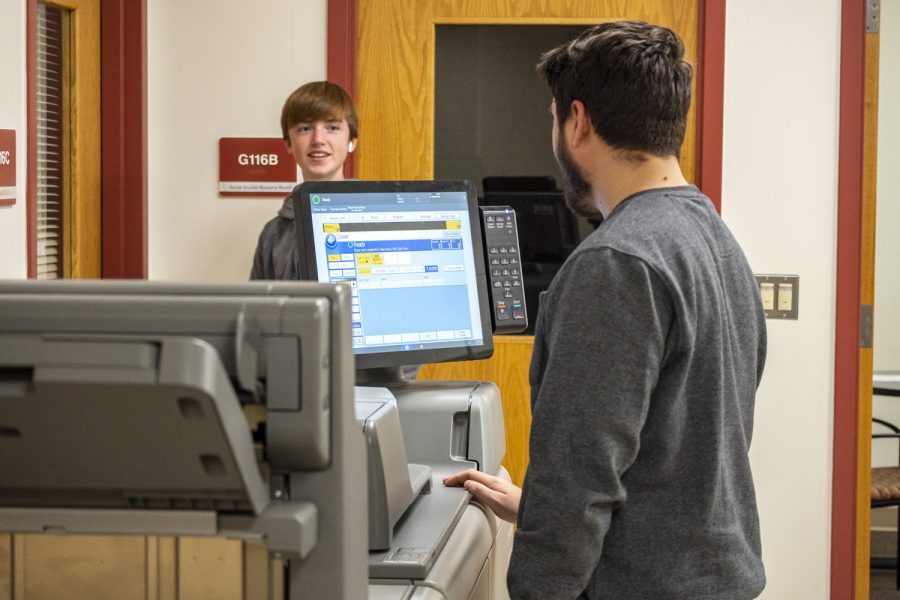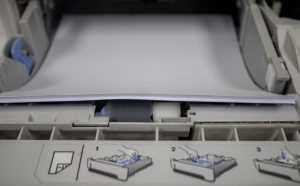Paper shortage complicated by unpredictability of Wi-Fi
Spanish teacher Evan Greenwald uses the G Hallway copier to print homework for his classes on Dec. 20, 2022. Teachers have to pay attention to their paper use due to the current paper shortage.
June 15, 2023
The school district continues to make adjustments to supply in order to save resources during the ongoing national paper shortage, while the situation is compounded by the lack of stable internet connection.
The spread of COVID-19 and the closure of schools nationwide led to an initial decrease in the demand of plain copy paper, causing many manufacturers to transfer to production of higher-demand packaging materials. The war between Russia and Ukraine has further damaged the market in recent years, with Russia being a major fuel supplier to various industries around the globe.
As society recovered from the lockdown period, the reopening of schools and offices caused a sharp spike in demand that suppliers were unable to meet, leaving them no choice but to increase prices for paper materials. In a memo sent to all teachers in the Northborough-Southborough district on Nov. 21, Superintendent Greg Martineau advised teachers to be conscious of classroom paper usage as prices rise.
“The cost of a case of paper has tripled, and the paper market is feeling the impact of supply chain challenges and freight costs,” the memo reads. “These increased costs are being passed on to us, the consumer.”
Martineau informed educators that although a substantial amount of printer paper has been purchased for the 2022-2023 academic year, the district is unable to order more should the supply run out. This differs from prior years when extra paper could be ordered as needed towards the end of the year.
Director of Finance for the Northborough-Southborough Public School District Rebecca Pellegrino, who oversees the budget and money allocation for the district, has been working around the obstacle since the reopening of the schools for the 2021-22 school year.
“We’ve been seeing shortages with our suppliers for a little over a year now,” Pellegrino said. “Paper is harder to come by and definitely more expensive to purchase.”
In simple terms, Pellegrino attributes the shortage to fluctuations in supply and demand since the start of the pandemic.
“During the pandemic, there were a number of paper mills… that saw a decrease in the demand for paper at that time,” Pellgrino said. “Now that people are back in the office or at school, there’s more of a demand for the product.”
Principal Sean Bevan affirms that paper accounts for a large portion of the district’s budget, making it difficult to allocate additional funds to restock.
“Paper is probably one of our biggest budget items that’s not staffing and salary,” Bevan said. “There’s only so many pens, pencils and paper clips to buy, but there’s lots of paper.”
This year, Bevan adds, an abnormal amount of paper is being used compared to previous years.
“Currently [we’re using] more paper than is typical,” Bevan said. “Even though we asked teachers to be really mindful of that, they’re doing the best they can with what they have.”
Bevan attributes this increase in paper usage to the frequent Wi-Fi issues the school is experiencing, causing many teachers to switch to paper-based lessons and classwork.
“The difficulty is this paper shortage is being compounded by the fact that our internet has had spotty, sporadic stability, so those make for a bad combination.” Bevan said.
AP World History teacher Nathaniel Uttaro has found that teachers are faced with a dilemma, given both the shortage of copy paper and unreliability of the Internet connection.
“It’s a no-win situation, because we’re supposed to limit our paper use,” Uttaro said. “However, the remedy for doing that is to put everything online, which students are unable to access, so it’s basically a catch-22.”
Although Uttaro makes an effort to limit his paper usage, he recognizes that the distribution of paper copies is often unavoidable in the current circumstances.
“At this point, I’m making copies of what I need to make copies of,” Uttaro said. “I’ll have to cross the ‘paperless’ bridge when we get there; I can only think day-to-day at this point.”
Uttaro continues to push for awareness when it comes to the effects of overproduction of paper and the environmental implications of its use.
“As an environmentally conscious person, I do try to minimize the use of paper whenever possible,” Uttaro said. “That is absolutely the goal, and over the years I’ve been able to really cut down the amount of paper I use on a weekly basis…when the Wi-Fi is fixed I will certainly continue to do just that.”












